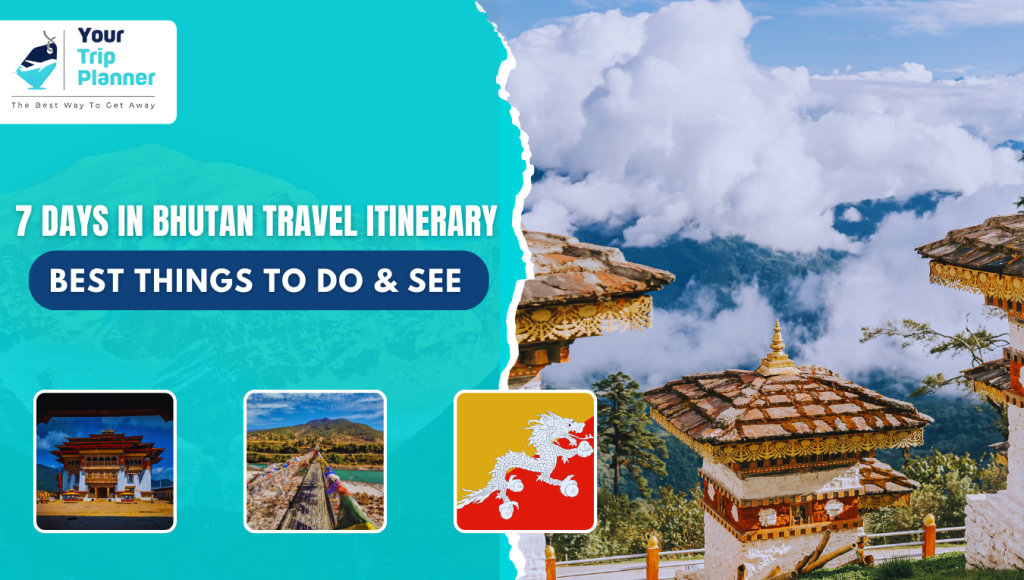Planning a 7-day itinerary for Bhutan allows you to delve deep into the cultural richness, natural beauty, and spiritual serenity that this Himalayan kingdom offers. Whether you’re drawn to ancient monasteries nestled in misty mountains, vibrant festivals that celebrate Bhutanese traditions, or adventurous treks through pristine landscapes, Bhutan promises an unforgettable journey. In this comprehensive guide, we outline the best things to do and see during your 7-day exploration of Bhutan.
Day 1: Arrival in Paro
Explore Paro Valley
- Paro International Airport: Begin your journey at Paro International Airport, where you’ll be greeted by the stunning views of the Himalayas as you land in one of the world’s most scenic airports.
- Tiger’s Nest Monastery (Taktsang): Embark on a hike to the iconic Tiger’s Nest Monastery, perched precariously on a cliffside 900 meters above the Paro Valley. This sacred site is a must-visit for its breathtaking location and spiritual significance.
- Paro Rinpung Dzong: Visit Paro Rinpung Dzong, a fortress-monastery that houses administrative offices and monastic quarters. Explore its intricate architecture, beautiful murals, and serene courtyards.
- National Museum of Bhutan: Discover Bhutanese history and culture at the National Museum, located in a former watchtower above the Paro Rinpung Dzong. Exhibits include traditional art, weaponry, and relics.
- Evening in Paro Town: Stroll through Paro town, browse local handicraft shops, and sample Bhutanese cuisine at one of the cozy restaurants.
Day 2: Traveling Paro to Thimphu
Journey to Thimphu
- Scenic Drive: Travel from Paro to Thimphu, the capital city of Bhutan, enjoying picturesque views of lush valleys, terraced fields, and traditional Bhutanese villages along the way.
- Memorial Chorten: Visit the Memorial Chorten, a stupa dedicated to the third king of Bhutan. Join locals in circumambulating the chorten and observe their devout prayers.
- Buddha Dordenma Statue: Marvel at the massive Buddha Dordenma statue overlooking Thimphu Valley. This 51-meter-tall bronze statue is a symbol of peace and prosperity.
- Tashichho Dzong: Explore Tashichho Dzong, an impressive fortress-monastery that serves as the seat of Bhutan’s government and houses the throne room and offices of the king.
- Craft Market: Wander through Thimphu’s Craft Market, where artisans sell a variety of traditional handicrafts, textiles, and Bhutanese souvenirs.
Day 3: Thimphu Exploration
Cultural and Spiritual Delights
- Changangkha Lhakhang: Visit Changangkha Lhakhang, an ancient temple perched on a hilltop above Thimphu. Receive blessings for your journey and enjoy panoramic views of the city.
- Folk Heritage Museum: Gain insight into traditional Bhutanese rural life at the Folk Heritage Museum, which showcases artifacts, household items, and exhibits on Bhutanese customs.
- Zilukha Nunnery: Explore Zilukha Nunnery, home to Buddhist nuns engaged in religious studies and daily rituals. Experience the peaceful atmosphere and interact with the nuns.
- Centenary Farmers’ Market: Immerse yourself in the vibrant atmosphere of the Centenary Farmers’ Market, where farmers from across Bhutan sell fresh produce, local delicacies, and handmade goods.
- Traditional Arts School: Visit the Traditional Arts School (Zorig Chusum), where students learn traditional Bhutanese arts and crafts such as painting, sculpture, and woodcarving.
Day 4: Reach Thimphu to Punakha
Journey to Punakha Valley
- Dochula Pass: Stop at Dochula Pass (3,100 meters), known for its panoramic views of the Himalayas. Admire the 108 chortens (stupas) and enjoy a cup of tea amid the mountain scenery.
- Punakha Dzong: Explore Punakha Dzong, the second oldest and arguably the most beautiful dzong in Bhutan. Located at the confluence of the Pho Chhu and Mo Chhu rivers, this fortress-monastery is a masterpiece of Bhutanese architecture.
- Chimi Lhakhang: Visit Chimi Lhakhang, also known as the Fertility Temple, dedicated to the Buddhist saint Drukpa Kunley. The temple is a pilgrimage site for couples seeking blessings for fertility and childbirth.
- Punakha Suspension Bridge: Cross the Punakha Suspension Bridge, one of the longest suspension bridges in Bhutan, offering scenic views of the Punakha Valley and the rivers below.
Day 5: Punakha Exploration
Cultural Immersion and Natural Beauty
- Sangchhen Dorji Lhuendrup Nunnery: Visit Sangchhen Dorji Lhuendrup Nunnery, perched on a ridge overlooking the Punakha Valley. Admire the intricate wall paintings and enjoy panoramic views.
- Punakha Valley Excursion: Explore the scenic Punakha Valley, known for its terraced rice fields, traditional farmhouses, and serene countryside.
- Rural Village Experience: Experience rural Bhutanese life with a visit to a traditional farmhouse. Learn about traditional farming practices, enjoy a home-cooked meal, and engage with the local community.
- White-Water Rafting: For adventure enthusiasts, opt for a white-water rafting experience on the Mo Chhu or Pho Chhu rivers. Navigate through thrilling rapids surrounded by lush vegetation and dramatic landscapes.
Day 6: Punakha to Paro
Return to Paro and Cultural Encounters
- Return Journey: Travel back to Paro from Punakha, retracing your route through scenic landscapes and traditional Bhutanese villages.
- Kyichu Lhakhang: Visit Kyichu Lhakhang, one of the oldest and most sacred temples in Bhutan. Marvel at its ancient murals, statues, and the peaceful surroundings.
- Free Afternoon: Enjoy a leisurely afternoon in Paro. You may revisit favorite spots, indulge in shopping for souvenirs, or simply relax and soak in the tranquility of Bhutan’s natural beauty.
- Cultural Performance: Attend a traditional Bhutanese cultural performance in the evening, featuring colorful dances, lively music, and elaborate costumes.
Day 7: Departure from Paro
Farewell to Bhutan
- Final Moments: Depending on your flight time, take a final stroll through Paro town, reflecting on your journey through the Land of the Thunder Dragon.
- Airport Transfer: Transfer to Paro International Airport for your departure flight, bidding farewell to Bhutan with cherished memories and a heart filled with the beauty and tranquility of this enchanting kingdom.
Practical Tips for Your Bhutan Journey
Packing Essentials
- Clothing: Pack layers suitable for varying temperatures, including warm clothing for higher altitudes and comfortable attire for temple visits.
- Footwear: Comfortable walking shoes or hiking boots are essential, especially if you plan to hike to Tiger’s Nest Monastery or explore rural areas.
- Travel Documents: Ensure you have your passport, Bhutan visa clearance letter, travel insurance, and any necessary medications.
Cultural Etiquette
- Respect for Customs: Respect Bhutanese customs and traditions, such as removing shoes before entering temples and dzongs, and dressing modestly.
- Photography: Ask for permission before photographing people, especially monks and religious ceremonies.
Altitude Considerations
- Acclimatization: Take it easy during the first few days to acclimatize to Bhutan’s high altitude, particularly in Paro and Thimphu.
Connectivity and Communication
- Internet: While major hotels offer Wi-Fi, internet connectivity may be limited in remote areas. Consider purchasing a local SIM card for mobile data.
Responsible Travel
Environmental Conservation: Support Bhutan’s commitment to environmental conservation by minimizing your environmental impact and respecting wildlife and natural habitats.
Conclusion
A 7-day itinerary in Bhutan offers a balanced blend of cultural exploration, natural beauty, and spiritual enrichment. Each day presents new opportunities to discover Bhutan’s unique charm, from ancient dzongs and monasteries to scenic landscapes and warm hospitality. Whether you’re a first-time visitor or returning to delve deeper into Bhutan’s treasures, Your Trip Planner ensures a seamless journey filled with unforgettable experiences. Contact us today to start planning your dream itinerary and embark on a transformative adventure in the Land of the Thunder Dragon.

